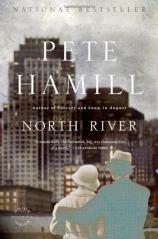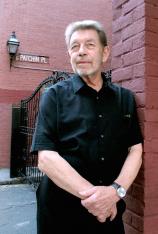North River
Review
North River
Pete Hamill has been one of America’s greatest writers for the past four decades. Author of 20 books, he has written bestselling novels and memoirs, as well as screenplays and countless works of journalism. He is a craftsman who transcends genres.
NORTH RIVER is Hamill’s masterpiece. As a young man studying art in Mexico, he aspired to be a painter. And here he has painted a masterpiece with words. No writer is more closely associated with New York City than Hamill. But to say that NORTH RIVER is about New York is like saying that Casablanca is a movie about Morocco.
This is a love story for the ages but without an ounce of sentiment, self-pity or fat. It explores the possibility of finding love and redemption in a world of pain hurling towards the abyss of destruction. It is a story, in the words of the main character, about “making loss into triumph, sorrow into life.” This book will make a heck of a movie someday.
The story is set in the western edge of lower Manhattan in 1934, a few blocks from the North River, which is now called the Hudson River. North River was the name used by New Yorkers going back to the days of the Dutch settlement. Dr. James Finbar Delaney is the neighborhood doctor.
New York is in the grip of what everybody calls “the goddamned depression.” Times are hard. They are made worse by the memories people carry of places named Somme, Verdun and Argonne; the ghosts of the war called “great” by those who profited from it still fill neighborhood apartments and stores in the fading photos of the forever young dead. Some things, sadly, never change.
Dr. Delaney is a deeply wounded man as the novel starts, both physically and psychologically. He still carries painful shrapnel in his shoulder, a wound that destroyed his dream of becoming a surgeon. He is alone and emotionally numb, his personal life a ruin. His only child, Grace, ran off to Mexico with her revolutionary husband and their infant child three years before. And then his beloved wife, Molly, simply walked out of his life 16 months before.
Hamill writes, “That summer evening, Molly walked toward the North River. She was alone, wearing a blue dress…wrapped in a shroud of her own hard solitude…She never came back. O, my Molly-O.” Delaney is a man haunted by the past and in dread of the future.
So he throws himself into his work, treating “the endless casualties of the night…the battered, hurt, desperate people of the parish.” He tries his best at a time when few could afford preventative health care --- or any health care at all for that matter. And there were few cures for common diseases. The word “polio” strikes terror in the hearts of parents. By the time many people get sick enough to seek help, a hospital stay will often turn into a one-way ticket to the bone yard.
Hamill writes of Dr. Delaney, “More than ever he understood that he needed their pain to keep from thinking about his own.”
Then his shaky existence is thrown into chaos when on New Year’s Day, with the city still blanketed beneath a blizzard, a baby is left on his doorstep. But this is no ordinary child; it’s his three-year-old grandson, Carlito, abandoned by his mother with nothing more than a note. She explains that she must go to Spain in search of her husband, and does not know when she will return.
Delaney is in no way able to take care of a child. Then Hamill shows us a side of New York that few outsiders know. People who have never spent time in the city think of New York as a monolith of concrete, glass and anonymity. But like all great cities, it is a city of small, often tightly knit, neighborhoods. That is still true to this day. And the North River neighborhood rallies to the doctor’s aid. People know people who know people, and pretty soon the doc has the help of a Sicilian immigrant woman to take care of the boy.
In Rose Verga, Hamill has created another unforgettable character. Rose brings to the doctor’s house a “tough warmth.” But she is also badly damaged by her past, and, like many immigrants, she is on the run from something. She is also here “without papers.” Rose is just the type of person many in Congress would like to bar from these shores today. But in New York, people like Rose historically became part of the muscle and intelligence that made this the greatest city in the history of the world. Who cares about your past when there is a future to be built here and now?
Delaney begins to see his city through the eyes of the boy, which is a brilliant device Hamill uses to show us the El speeding past crowded tenements where people lived “with the constant roar of the trains.” He takes the boy to Grand Central Terminal, the both of them “seeing beams of light pushing down from high arched windows to the station floor, and a ceiling that was blue and flecked with stars, and a wide marble staircase rising as if in a palace.”
With Carlito and Rose now in his life, Delaney finds that “Death and pain and longing went away, like smoke rising from a ruin.” When he holds the boy tight he can feel “a little ice melting in his frozen heart.”
But there are external and internal threats to his new happiness. Delaney gets involved in the middle of a mob war when he saves the life of a fellow soldier, now gangster. The FBI is after him because of his daughter’s left-wing politics. Years before the Patriot Act, J. Edgar Hoover’s FBI displays little concern about warrants and the Bill of Rights. Then, there is the ever-present ticking clock: What will happen when Grace returns home, and will Rose be forced to run again?
The descriptive writing in this book is simply breathtaking. A tenement is a “grim factory for making children, and criminals, and illness.” Dread is “something out of rainy dawns with fixed bayonets.” A couple finding love again “did many things with each other, like humans finding water after a drought.”
As with all of Hamill’s writing, there is an incredible sensitivity and humanity here. His career has been marked by a concern for the powerless and forgotten, and has long spoken out for justice and peace. NORTH RIVER is a portrait of New York from its streets and people; it is a people’s history of the 1930s. We see how poverty, despair and alcohol abuse lead to horrific domestic violence.
“Drunks were no threat to power,” he writes, wisely pointing out that when the poor destroy themselves, the powers that be are left unscathed.
But it is the characters of Jim and Rose that will stick with you long after you put this book down. Like a magical night at Roseland, listening and dancing to the greatest romantic music America ever produced, you will not want this story to end. You will turn the last page wishing to spend more time with Jim and Rose in the Lost World of New York. This is a book that will bring a smile to your face and a tear to your eye; it will make you want to cheer.
Pete Hamill told me years ago that writing always had to be a craft before it could become an art. In NORTH RIVER, Hamill has produced a true work of beautiful art. This great book is not only one of the best novels of 2007, it is one of the best books of recent years. It will become a classic story of New York, hope and the importance of “having a life, no matter what.
Reviewed by Tom Callahan on January 13, 2011
North River
- Publication Date: June 4, 2008
- Genres: Fiction, Historical Fiction
- Paperback: 368 pages
- Publisher: Back Bay Books
- ISBN-10: 0316007994
- ISBN-13: 9780316007993










